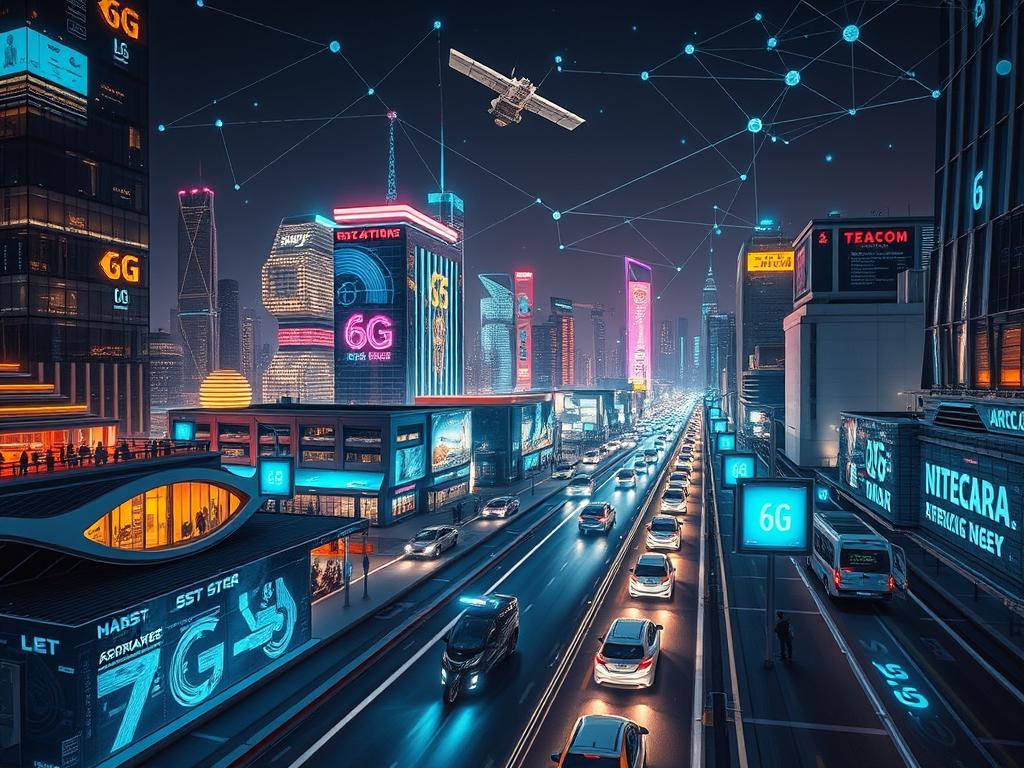Did you know that the upcoming 6G networks are expected to deliver a staggering connection speed of up to one terabit per second and a latency of only 0.1 milliseconds? This remarkable advancement is set to redefine the future of the Internet, improving our connectivity and transforming our everyday lives. As global efforts increase to develop this next-generation technology, we stand on the brink of a connectivity revolution that promises to integrate digital, physical, and human interactions more seamlessly than ever before.
Scheduled to launch around 2030, 6G technology aims not only to enhance the speed and capacity of our networks but also to introduce immersive experiences such as holographic communication and augmented reality. With innovations like advanced radio equipment and the extensive use of the electromagnetic spectrum, the potential applications of 6G are limitless, paving the way for digital transformation across various sectors.
Join us as we explore how 6G technology will change our lives and set the stage for the next generation of communication.
Key Takeaways
- 6G networks promise maximum speeds of up to one terabit per second.
- A remarkable latency of just 0.1 milliseconds is projected for 6G technology.
- This new technology will facilitate immersive experiences through AR, VR, and even holograms.
- 6G aims to enhance network coverage globally, especially in underserved areas.
- The expected deployment of 6G around 2030 will usher in a new era of connectivity.
- With its advanced capabilities, 6G is set to revolutionize industries from healthcare to transportation.
What is 6G Technology and How Does It Work?
6G technology represents a groundbreaking advancement beyond its predecessor, 5G. It envisions a future with data transfer rates potentially reaching up to one terabit per second, a remarkable leap that could transform communication and connectivity. This technology is set to redefine performance standards by incorporating a variety of modern applications that extend far beyond mobile devices.
Overview of 6G Technology
This new generation of wireless communication will utilize higher frequency bands and advanced radio equipment to support a significant number of devices within a localized area. With projections of supporting up to 10 million devices per square kilometer, 6G aims to facilitate the Internet of Everything (IoE) by enhancing connectivity across sectors. Various organizations, including Keysight Technologies and Huawei, are heavily investing in research and development of 6G technology.
Differences Between 5G and 6G
The differences between 5G and 6G are substantial. While 5G supports speeds up to 10 Gbps, 6G is expected to reach up to 100 Gbps or even higher. Moreover, latency in 6G technology may drop to as low as 0.1 milliseconds, vastly outperforming 5G’s latency of 1 millisecond. This improvement is crucial for applications that demand instantaneous data exchange like telemedicine and autonomous driving.
Technical Innovations Driving 6G
Technical innovations driving 6G encompass a wide range of advancements, including the convergence of technologies such as AI and edge computing. This integration will optimize network management and security, enabling personalized user experiences and real-time problem-solving. Terahertz spectrum utilization further enhances bandwidth and speed, allowing for efficient data transfer that far exceeds current wireless capabilities.

The potential applications for 6G technology span various fields, including smart healthcare practices, where high-speed connectivity can improve diagnostics and surgical precision. As these technologies continue to evolve, the landscape of communication will undergo transformative changes, making 6G a crucial development for the future of connectivity.
Explore how VR andAR are shaping healthcare.
Expected Improvements in Connectivity
The rollout of 6G technology signifies a transformative leap in connectivity standards, promising users a wealth of enhancements that will redefine digital interaction. From blazing fast data transfer to broader access, these changes cater to both individual and communal needs across multiple realms.
Ultra-Fast Data Speeds
Projections indicate that 6G technology will deliver data transmission speeds up to 100 times faster than 5G. This leap into the terabit-per-second range enables users to enjoy ultra-fast data speeds that allow immediate information exchange. As a result, applications such as augmented reality and ultra-HD video streaming will flourish, creating a seamless digital experience that meets growing consumer demands.
Lower Latency
With a targeted air-interface latency of as low as 10 microseconds, 6G technology will significantly enhance real-time interactions. This reduced latency leads to improvements in applications requiring instantaneous feedback, such as autonomous driving and remote surgery. A new era of effective communication will emerge, enabling smoother online gaming, video conferencing, and similar activities reliant on lower latency.
Enhanced Network Coverage
The vision for 6G includes overcoming barriers to connectivity, especially in underprivileged and rural areas. Various initiatives aim to achieve enhanced network coverage by connecting up to 10 million devices per square kilometer. This ensures that everyone can access superior connectivity, fostering an inclusive environment where digital transformation benefits all communities. Organizations and individuals alike will be empowered to thrive in this new digital landscape.

As technology continues to evolve, it is vital to embrace advancements that facilitate increasing connectivity. The integration of new materials, AI, and standards will guide the way towards realizing these ambitious goals, ensuring that society can adapt to the changing technological terrain.
| Feature | 5G | 6G |
|---|---|---|
| Peak Data Rates | Up to 20 Gbit/s | Terabit-per-second range |
| Connection Density | 1 million devices/km² | Up to 10 million devices/km² |
| Latency | 1 millisecond | 10-100 microseconds |
| Radio Spectrum Efficiency | – | 5 times higher than 5G |
| Technological Innovations | Enhanced Mobile Broadband (eMBB) | Advanced AI integration, Massive Machine-Type Communications (mMTC) |
Transforming Daily Life with 6G
The integration of 6G technology into our daily lives promises unprecedented transformations. Its capabilities impact various areas, including smart homes, remote work, and healthcare. As we explore these changes, it becomes evident that 6G will redefine how we interact with technology and each other.
Smart Homes and IoT Integration
With the advent of smart homes and IoT integration, 6G technology will enable devices to communicate seamlessly. Enhanced connectivity allows appliances to learn user behaviors, optimizing energy consumption and personalizing living environments. The improved data transmission speeds of up to 1 terabit per second will promote real-time interactions between devices, creating a truly interconnected home experience.
Future of Remote Work and Learning
Remote work with 6G will revolutionize how we collaborate and learn. Virtual environments will become more immersive thanks to ultra-fast data rates supporting methods like augmented and virtual reality. This technology will empower individuals to work effectively from home, controlling industrial machinery and participating in projects as if they were physically present alongside their colleagues. A future where collaboration feels authentic, regardless of distance, is on the horizon.
Advances in Telemedicine
Advances in telemedicine will enable healthcare professionals to monitor patients remotely in real-time. The capabilities of 6G will facilitate immediate data exchange, enhancing healthcare access and outcomes across various demographics. From remote consultations to quick diagnostics, this technology will ensure that patients receive timely care, irrespective of their location.

6G is expected to redefine digital in numerous ways, making life easier and more connected than ever before. Embracing these advancements will prepare society for a future where technology plays a central role in enhancing our experiences at home, work, and in healthcare.
Impacts on Industries and Economy
The advent of 6G technology promises profound industrial impacts that will reshape sectors across the economy. By facilitating unprecedented connectivity and data handling capabilities, businesses can enhance existing models and create new opportunities. The combination of ultra-fast speeds and advanced features will drive innovation and investment, paving the way for significant economic growth.
Revolutionizing Transportation
6G is set to play a critical role in revolutionizing transportation. With its capacity to facilitate the operation of autonomous vehicles through real-time data exchange, road safety and efficiency will markedly improve. This technology will support networked traffic management systems, reducing congestion and optimizing travel routes. Such advancements create a landscape conducive to smarter mobility solutions, making transportation more efficient and environmentally friendly.
Changes in Manufacturing and Supply Chains
The manufacturing sector will experience considerable transformations as companies harness 6G’s capabilities to streamline processes. Enhanced connectivity allows for real-time data analysis, enabling better inventory management and operational efficiencies. In this way, businesses can utilize 6G to create responsive supply chains that adapt swiftly to market demands, thus driving competitiveness and productivity.
Potential for New Business Models
With the transition to 6G, there will be a significant emergence of new business models with 6G. Companies can capitalize on the expansive data analytics and machine learning insights made possible by this technology. By selling data generated through advanced sensing capabilities, industries can unlock new revenue streams. The integration of 6G in various sectors necessitates an investment in skills and infrastructure as businesses adapt to this transformative landscape.
| Sector | 6G Impact | Future Outlook |
|---|---|---|
| Transportation | Enhanced road safety, autonomous vehicle integration | Smart mobility solutions, reduced congestion |
| Manufacturing | Real-time data analysis for efficiency | Responsive supply chains, improved productivity |
| Business Models | New revenue from data sales and analytics | Innovative services leveraging 6G technology |
As industries prepare for the deployment of 6G by 2030, the groundwork for a revolutionary economic landscape is already being laid. The transformative potential of 6G will not only change how industries operate but will also redefine the overall economic fabric.
The Role of 6G in Artificial Intelligence
The upcoming 6G technology is set to revolutionize the landscape of artificial intelligence, creating a synergetic environment for both. With capabilities projected to be 10 to 100 times faster than 5G, 6G will empower AI in ways previously unimagined. The integration of 6G will enhance various AI-driven applications across multiple sectors, optimizing performance and functionality.
AI-Driven Applications
As 6G is implemented, AI-driven applications will evolve significantly. Enhanced speed and reduced latency will enable real-time processing of vast amounts of data, which is crucial for applications in transportation, healthcare, and personal assistance technologies. From autonomous vehicles to smart healthcare solutions, the potential for AI applications will expand remarkably.
Enhanced Data Processing Capabilities
Data processing capabilities with 6G will outstrip those of previous generations, allowing for improved analytical insights and faster decision-making processes. The high-performance capabilities of 6G networks will facilitate complex computations in machine learning and predictive analytics, impacting how businesses operate and make strategic decisions.
Collaboration Between AI and 6G
The collaboration between AI and 6G stands to redefine multiple industries. Energy-efficient AI-driven sleep states will help optimize the energy consumption of 6G networks. Moreover, industries will leverage AI to automate network management, thus enhancing reliability and performance. This partnership will be vital in fields such as industrial automation, smart cities, and immersive experiences in virtual and augmented reality.
| Feature | 5G | 6G |
|---|---|---|
| Speed | Up to 10 Gbps | 10 to 100 times faster |
| Latency | Low (up to 10ms) | Significantly reduced |
| Telecommunication Spectrum | Below 6 GHz | 6.4 to 15 GHz (preferred 6.4 to 7.1 GHz) |
| Network Demand | Moderate | Significantly high |
| AI Integration | Basic | Advanced self-optimization and automation |
Challenges and Considerations for 6G Implementation
As we anticipate the rollout of 6G technology in the early 2030s, it’s important to recognize the various 6G implementation challenges that will arise. A primary concern lies in the significant infrastructure development and investment required to transition from existing networks. As predicted, achieving the necessary upgrades will demand substantial financial resources and strategic planning to support the network’s increased energy efficiency and coverage capabilities.
Infrastructure Development and Investment
The successful deployment of 6G hinges on substantial infrastructure improvements. Unlike its predecessors, 6G is expected to deliver data speeds up to 1 terabit per second and drastically lower latency. This necessitates a tenfold increase in network efficiency over 5G and emphasizes the need for investment in modern technologies. Such infrastructure development is critical for accommodating new applications like virtual reality and autonomous systems.
Cybersecurity Risks
With the expansion of device connectivity, cybersecurity risks in 6G networks will escalate. As the technology allows a massive increase in traffic processing, robust security protocols must be established to protect sensitive data. Stricter requirements for privacy and security measures will be indispensable to address the advanced threats posed by 6G applications. Companies must prioritize the development of decentralized security systems to safeguard against potential vulnerabilities.
Regulatory and Policy Issues
In addition to infrastructural and security challenges, regulatory issues concerning 6G will play a significant role in its implementation. Ensuring proper spectrum allocation and developing international standards requires collaboration among governments, industry leaders, and regulatory bodies. Comprehensive guidelines are essential to manage the complexities associated with this new generation of wireless technology, paving the way for a smoother transition into a more connected future.











